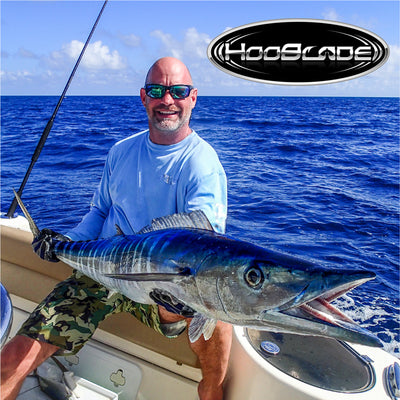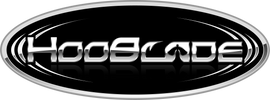Rigging
With the HooBlade being used in so many regions, the differences in rigging and tactics is mind boggling. And in many instances, for the exact same target species. Everything from the HooBlade being used as a slow speed bird (2-3kn) behind a kayak to legit high-speed trollers. Some running a naked ballyhoo with no weight to skip on the surface all the way to spreads with the lightest lure being an 8oz lead head. And the topic that elicits the most emotion…the sacred ballyhoo. Some hiding their rigging techniques like grandma’s secret lasagna recipe.
First things first. Drag anything at any weight behind your boat by a rope or line and it will eventually surface as speed increases. The spinning blade on the HooBlade amplifies this so whatever you are dragging will surface sooner (at a slower speed) than without it.
If you want it to stay on the surface, you’re golden. In most cases running it high off an outrigger or moving your rods to the leaning post or rocket launchers isn’t necessary but an option a very slow speeds or with heavy lures.
If you prefer it run under the surface, here’s what we recommend (in order)…
1, Lower the Pull Point. Decreasing the angle of the line to the surface of the water is the easiest and most effective. For reference, a standard Ilander (specs below) starts to surface in my spread at 8.14 knots. With the HooBlade (blade and sleeve/cone) it starts to surface at 4.7 knots. Lowering the Pull Point approx. 5 feet from the rod tip to a release clip on a cleat raises the speed in which the lure surfaces to 6.3 knots (gain of 1.6 knots). Lowering it just 2 feet more to a release clip closer to the water line nets another 1.2 knots making the HooBlade equipped Ilander surface at 7.5 knots. I’m assuming the jump in speed with that last two feet is due to the fact the majority of the line is now in the water, increasing drag to help keep it down. If you still haven’t reached your target speed, move to #2.
2, Add Weight.
Before we get into weight, let’s talk ballyhoo. Opinions vary wildly and seems to be a regional thing. In regards to the HooBlade, a chin weight shouldn’t be used to keep it from spinning (you have a different problem that needs to be addressed) but rather to keep it down. I personally prefer the presentation and speeds (cover more water) you can obtain with heavier weights. I use a 1.5 oz. with a medium hoo starting at 4 knots. Depending on where you are from, 1.5 oz is a bowling ball, to some of you it’s a BB.
Back to weight. The speed at which the Ilander above surfaces increases to just over 8 knots with the addition of a 2 oz egg sinker behind the head of the lure. Use caution with smokers not to obstruct the exit holes in the back of the head.
Weight alone may not be enough to get the results you are after, I have a 6oz one-off bullet that surfaces at 9 knots with a HooBlade (approx pull point 8.5’ from water surface).
3, Slow Down. That may not be an option for some but may be the final tweak you need to get every lure in your spread behaving as they should.
4, Lastly, Let Line Out. Running a lure further back in your spread is essentially the same as lowering the pull point. It decreases the angle of the line to water. Letting some line out will help when lowering the pull point isn’t an option.
Beyond six knots, planers are a great option. A #1 is too small and will trigger from the drag. Start with a #2 and work up depending the desired depth.
In short, running it on the surface is a non-issue. Same if you are running it with a planer, down-rigger, Troll Pro, or trolling lead. If you are somewhere in the middle of speed (4-6knots) and weight (less than 4oz), some tuning is involved. And of course it’s unrealistic to expect one product to meet every need so don’t hesitate to let me know if you just cant reach your desired results.
Circle Hooks and Ballyhoo
I don’t personally fish billfish tournaments and honestly wasn’t even thinking circle hook during the design process. The topic came up and quite a few capts have been working on it. The best option I’ve seen so far is simply a loop of rigging wire coming out of the front of the sleeve. The loop is left open till ready to use. When ready, insert the circle hook into the loop and twist until you’ve reached the desired orientation and distance from sleeve. The hook will be completely exposed. I don’t have any real numbers for you at this point but chances are good you aren’t getting your HooBlade back.
Blade Only
If you are using the blade only, be sure to use the appropriate size and style bead so they don’t create additional friction and/or prevent the blade from spinning. And if you are using a crimp in the front to keep everything in place, be sure to leave enough room so everything spins freely.
Live Bait
The HooBlade wasn’t designed for use with live bait but some are using it with success. Stick with the hearty swimmers and remember the cone is going to suffocate the ram breathers. In this case use the Blade only with beads for clearance.
Line Twist
To date we’ve only had two incidents of line twist being an issue.
1, The Capt was experienced so it wasn’t a rigging issue. Still trying to figure that one out and have tried replicating the situation with no luck. He was running it on the surface with a small chin weight so my guess is that it popped free on a wave and tangled up in its own line.
2, In this case we are pretty sure what happened. The ballyhoo with a HooBlade crossed the flat line next to it, tangled, and created a mess.
In both cases, the blade made EVERYTHING spin.
Obviously a spinning blade is not a new concept in fishing. The benefits of the vibrations are irrefutable from the decades of positive results experienced from the use of spinners and buzz baits in fresh water. Now we finally have one for trolling application.
Hope this helps and please stay in touch. I truly appreciate the feedback.
All the best,
Tim League
HooBlade
Ilander specs:
An Ilander was chosen as a reference due to it’s wide use and popularity. You’ll need to make adjustments based on your unique circumstances but it’s a great reference point.
Weight 2.1oz (actual weight)
Single Mustad 7/0 J hook
9’ 80# Fluorocarbon Leader
60# Mono main line with ball bearing swivel
Seas flat calm - I’m talking glass.
Pull point - starting pull point approximately 8.5’ from water surface off a rod tip.

